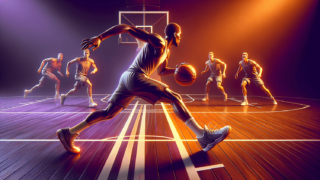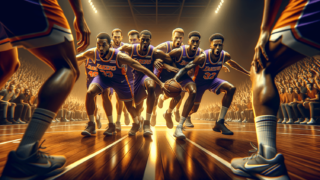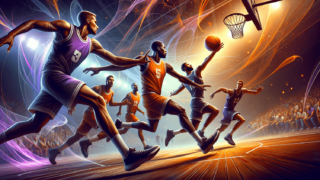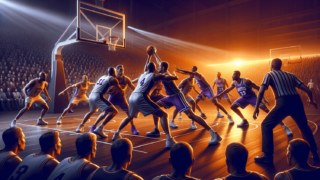
Defensive Three-Second Violation in Basketball: How It Affects the Game
Written by: Basketball Universe
Last updated:

Every avid basketball fan knows that defense is the unsung hero of the game, but few realize the intricacies that lie beneath the surface of every defensive play. Enter the scene, the often-elusive Defensive Three-Second Violation – our protagonist for today’s discussion. Despite its enigmatic status, this rule significantly impacts the flow and tactics of the game. So whether you’re a seasoned veteran or just dipping your toes into the realm of basketball, join us as we explore the fascinating world of Defensive Three-Second Violations, and how they affect the delicate balance between offensive dominance and defensive prowess.
Defensive Three-Second Violation in Basketball: How It Affects the Game
The Defensive Three-Second Violation is a rule in basketball that prevents a defensive player from standing in the key, or the restricted area beneath the basket, for more than three seconds without actively guarding an offensive player. This rule promotes fair play and increases offensive opportunities. When a violation occurs, a technical foul is called, and the opposing team receives one free throw and possession of the ball, disrupting the game’s flow and potentially affecting a game’s outcome.
The Core Tenets of Defensive Three-Second Violation
Before diving into the in-depth analysis of Defensive Three-Second Violation, let’s revisit the rule itself. As per the basketball rules, a defensive player is not allowed to remain in the key (the rectangular paint-covered area beneath the basket) for more than three seconds without actively guarding an offensive player. When a player violates this rule, a technical foul is assessed, the opposing team receives one free throw, and the possession of the ball. With these fundamentals in place, let’s explore the different aspects of this crucial rule.
Understanding the Key
The key, also known as the lane, is a crucial area in basketball that provides numerous offensive and defensive opportunities. Successfully controlling the key often leads to scoring points, drawing fouls, or gaining strategic advantages. In this section, we dive into the importance of the key and its relation to the Defensive Three-Second Violation.
Offensive Advantages in the Key
The key is the epicenter of offensive action. Players occupying the key are in prime position for layups, dunks, and high-percentage shots. Furthermore, the key provides offensive players with ample space for pick-and-rolls and pick-and-pops, allowing them to create opportunities for open shots.
Defensive Stakes in the Key
Defensive players face immense pressure in the key area as they strive to block and contest shots and limit points in the paint. Moreover, they aim to prevent easy passes to the basket and force the offense to attempt low-percentage shots. Consequently, defensive players must be mindful of their position and not violate the three-second rule, as penalties can be costly in a tightly contested game.
Applying the Defensive Three-Second Violation Rule
Now that we’ve discussed the importance of the key in basketball, let’s delve into the intricacies of the Defensive Three-Second Violation rule and its real-world application within the game.
When Does the Rule Apply?
The Defensive Three-Second Violation rule applies when a player is in a standard defensive stance without actively guarding an opponent. However, it’s worth noting that the rule does not apply under specific conditions, such as when a player is double-teaming an offensive player in possession of the ball, defending a cutter actively cutting through the key, or when the offensive team is in transition. Understanding these exceptions helps defensive players avoid unnecessary technical fouls.
Recognizing Active Defense
Identifying active defense can be ambiguous at times. However, referees usually interpret an “active” defensive position to include the following:
- The player is within arm’s reach of the opponent they’re guarding.
- The player is closely doing one of the following movements: pressuring the ball, fronting the offensive player, denying a passing lane, or actively switching between two offensive players.
- The player is physically and visibly engaging their assigned offensive player.
By keeping these criteria in mind, defensive players can minimize the risk of getting called for a Defensive Three-Second Violation.
The Ripple Effect of Defensive Three-Second Violations
In this section, we’ll explore how the implementation and consequences of the Defensive Three-Second Violation affect various facets of gameplay and strategy.
Influencing Defensive Strategies
The Defensive Three-Second Violation rule restricts players from simply standing or camping in the key, imposing a more demanding and dynamic defensive playstyle. Defenders must continuously reposition themselves, seek new challenges, and engage in active perimeter defense or the help-side defense. The rule encourages defenders to remain vigilant and attentive, leading to an intensified and exhilarating basketball experience.
Creating Offensive Opportunities
By limiting defenders’ ability to loiter in the paint, the Defensive Three-Second Violation rule opens up space for creative and opportunistic offensive plays. For instance, offensive players can exploit the gaps in the defense, drive to the basket, and capitalize on newfound openings. Moreover, the rule reduces the chances of offensive players being double-teamed in the paint, making it easier to draw fouls and score points.
Variable Impact on Different Playing Styles
The impact of the Defensive Three-Second Violation on individual players depends on their playing style and position. Centers and rim protectors might struggle the most, as they can no longer idle in the paint and wait for blocked shots. However, flexible and versatile players can adapt more easily, employing complex defensive tactics such as switching or zone defense to circumvent the rule. The implementation of this rule has led to the evolution of basketball, focusing on agile and coordinated defensive players instead of traditional big-men.
Tips for Avoiding the Defensive Three-Second Violation
Now that we’re familiar with the intricacies of the Defensive Three-Second Violation, let’s share tips to minimize the risk of being called for this violation on the court.
1. Develop Defensive Awareness
Anticipating and reacting to the offensive plays can help defensive players move quickly inside the key, closing out on opponents or contesting shots, keeping them active and engaged in defense.
2. Master Shot Blocking
Developing the skill to block shots without being stationed inside the paint is critical for avoiding the three-second rule. As players become increasingly proficient, they can continue to time their blocks and remain mobile without risking a violation.
3. Utilize Quick, Smart Footwork
Rapid footwork is essential for defensive players to switch between defending on the perimeter and protecting the paint without lingering for too long. Mastery of this technique helps defenders perform seamlessly, leaving no room for violations.
Appreciating the Defensive Three-Second Violation in Basketball
Despite being an oft-overlooked rule, the Defensive Three-Second Violation plays a vital role in shaping the modern game of basketball. With a clear understanding of the rule’s impacts and finesse, players and fans alike can appreciate the strategic complexities of basketball and foster a profound appreciation for the defensive efforts employed by players in every gripping matchup.
History of the Defensive Three-Second Violation
The Defensive Three-Second Violation has a fascinating history that dates back to the early 2000s. The rule was introduced during the 2001-2002 NBA season as a part of a series of rule changes designed to increase scoring and make the game more exciting for fans. Prior to the implementation of the rule, many teams employed big-men who would camp in the paint and deter offensive players from driving to the basket. This led to a slower-paced, lower-scoring game with fewer highlights. As a result, the Defensive Three-Second Violation was introduced to combat this issue and add a new dimension to the game, allowing it to flourish into what it is today.
Defensive Three-Second Violation in Different Leagues
While the NBA employs the Defensive Three-Second Violation rule, other leagues worldwide may or may not adopt the same rule or might have variations of it. For instance:
FIBA
In international basketball, as governed by FIBA, the Defensive Three-Second Violation is not utilized. Instead, a more lenient version called the defensive key rule applies, in which defensive players can only be called for a violation when they are inside the no-charge semicircle area for more than three seconds.
NCAA
In college basketball, governed by the NCAA, there is no Defensive Three-Second Violation. Instead, teams often employ zone defenses, which require players to guard specific areas on the court, thus allowing defensive players to remain inside the key for extended periods without penalty.
Understanding the different rules applied in various leagues can provide a broader perspective on the role and impact of the Defensive Three-Second Violation in basketball at the global level.
Improve Your Game with Defensive Drills
With a solid grasp of the Defensive Three-Second Violation, it’s essential to apply this knowledge to individual or team practice sessions to build defensive prowess. The following defensive drills can help players avoid committing this violation:
1. Shell Drill
Perform the classic shell drill, where the defense shifts in response to ball movement, practicing quick closeouts and rotations to ensure players are adhering to the violation rules.
2. Zig-Zag Drill
The zig-zag drill helps enhance lateral quickness, allowing players to defend more effectively on the perimeter, reducing their time spent in the key area, and thereby avoiding the possibility of a violation.
3. Timing and Agility Drills
Reinforce players’ shot-blocking abilities and defensive rotations through a series of timed exercises and agility drills, concentrating on maintaining excellent position while staying within the three-second limit.
Incorporating these drills into regular practice sessions will inevitably improve individual and team defense, ensuring a strong grasp of the Defensive Three-Second Violation and its implications on the game.
FAQ: Defensive Three-Second Violation in Basketball
We understand that the Defensive Three-Second Violation is a multifaceted rule, and you may have questions about its application, impact, and nuances in the game of basketball. To ease your inquiries, we’ve compiled a list of frequently asked questions (FAQ) and their answers below.
1. What is the Defensive Three-Second Violation?
The Defensive Three-Second Violation is a basketball rule that prevents a defensive player from remaining in the key (the restricted area under the basket) for more than three seconds without actively guarding an offensive player.
2. What is the penalty for a Defensive Three-Second Violation?
When a defensive player commits a Defensive Three-Second Violation, the opposing team is awarded a single free throw and retains possession of the ball.
3. Can a defensive player enter the key without actively guarding anyone?
A defensive player can enter the key without actively guarding an opponent; however, they must leave the key within three seconds to avoid a violation.
4. Is there a similar rule for offensive players?
Yes, the offensive three-second rule restricts offensive players from remaining inside the key for more than three seconds without the ball. If violated, the opposing team is awarded possession.
5. Does the rule apply when defending a player openly driving to the basket?
No, the Defensive Three-Second Violation does not apply when actively defending a player who is driving to the basket.
6. Are there any exceptions to the Defensive Three-Second Violation rule?
Yes, the rule does not apply when a player is double-teaming an offensive player with the ball, defending a cutter actively cutting through the key, or when the offensive team is in transition.
7. Is the Defensive Three-Second Violation applied in college basketball?
No, there is no Defensive Three-Second Violation in college basketball, governed by the NCAA.
8. When was the Defensive Three-Second Violation introduced in the NBA?
The Defensive Three-Second Violation was introduced in the NBA during the 2001-2002 season.
9. How can I avoid committing a Defensive Three-Second Violation on the court?
To avoid committing a Defensive Three-Second Violation, develop defensive awareness, master shot blocking, and utilize quick, smart footwork to maneuver in and out of the key in under three seconds.
10. Why was the Defensive Three-Second Violation rule introduced in basketball?
The rule was introduced to promote fair play, increase scoring opportunities, and prevent defensive players from camping in the key, which led to a slower-paced and less exciting game for fans.
Featured Posts
- No pillar pages found.





